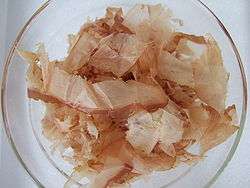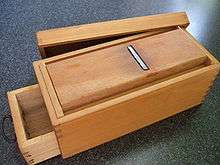Katsuobushi

Katsuobushi (Japanese: 鰹節) or okaka (おかか) is dried, fermented, and smoked skipjack tuna (Katsuwonus pelamis). Sometimes known as Bonito flakes, young bonito is sometimes used as a cheaper substitute for skipjack tuna, particularly in canned products, and has a similar color and texture, but not all countries allow marketing of bonito as skipjack tuna.
Shaved Katsuobushi and dried kelp - kombu - are the main ingredients of dashi, a broth that forms the basis of many soups (such as miso) and sauces (e.g., soba no tsukejiru) in Japanese cuisine.
Katsuobushi's distinct umami taste comes from its high inosinic acid content. Traditionally made katsuobushi, known as karebushi, is deliberately planted with Aspergillus glaucus fungus in order to reduce moisture. Katsuobushi has also been shown to impart a kokumi flavour.[1]
Upon being placed on hot food, the heat waves cause the thin and light katsuobushi to move about, giving it a special aesthetic look. It is placed on pizzas to make the top of the pizza seem alive with the "dancing" katsuobushi.
Traditional production process
The fish is beheaded, gutted and filleted. The fatty belly area does not lend well to being preserved, so it is also trimmed off. The fillets are then arranged in a basket and simmered just below boiling for an hour to an hour and a half, depending on the size of the fillets. The rib bones are removed after the fillets have been boiled.
The fillets are then smoked using oak, pasania, or castanopsis wood; this process can take up to a month. They are smoked for 5–6 hours in one session, left to rest for one day for the condensation to rise to the surface, then fired and smoked again the next day, repeating this smoking and resting cycle 12–15 times. The built up tar from the smoke is cleaned from the surface using a grinder. At this stage the fillets are called aragatsuo (荒節) and most commonly found in stores shaved and packaged for sale under the name katsuo-kezuri-bushi (鰹削り節) or hanakatsuo — they are not true katsuobushi without the last fermentation stage, but still valued as a good substitute.
The last stage of creating a katsuobushi is to allow the fish to sun-dry using the assistance of mold. The fillets are sprayed with Aspergillus glaucus culture and left for 2 weeks in a closed cultivation room. The mold ferments the fillets and also siphons out any residual moisture.
The mold is continually scraped off, with further sun-drying of the fish increasing hardness and dryness until it resembles a piece of wood, with less than 20% of its original weight. By definition, only fillets that have been treated in this manner may be referred to as a katsuobushi. However, after repeating this process of mold growth and sun-drying at least twice, the katsuobushi can also be called karebushi (枯節, "dried fillet"), and fillets repeating this process more than three times can be called honkarebushi (本枯節, "true dried fillet"). When tapped together lightly, they sound almost metallic, and unlike their dull beige outer appearance, when broken open they are a translucent deep ruby color inside. Rarely, very high-end honkarebushi repeat this drying process for over two years.[2]
Shaving

Traditionally, large chunks of katsuobushi were kept at hand and shaved when needed with an instrument called a katsuobushi kezuriki, similar to a wood plane.
Katsuobushi is today typically found in bags of small pink-brown shavings. Smaller, thinner shavings, called hanakatsuo (花鰹; はなかつお), are used as a flavoring and topping for many Japanese dishes, such as okonomiyaki. Larger, thicker shavings, called kezurikatsuo (削り鰹; けずりかつお), are used to make the ubiquitous dashi stock.
Uses
In addition to making dashi, other popular uses of katsuobushi include:
- Okaka (おかか), finely chopped katsuobushi dressed with soy sauce.
- As a stuffing for rice balls (onigiri).
- As a topping for rice. Popular for bentō, often covered with strips of laver.
- Dried okaka is used as an ingredient of furikake rice topping (called "okaka furikake").
- As a seasoning for cold tofu (hiyayakko, 冷奴) along with grated ginger and Welsh onion (a type of spring onion).
- Sprinkled with sesame seeds and chopped laver atop cold soba noodles (zarusoba).
- As a topping on takoyaki and okonomiyaki.
- As a seasoning on century egg along with sesame oil and soy sauce.
- As a high-protein treat for cats sold at pet stores.
- As a topping for ramen mixed with salt[3]
Health
The mycotoxin beta-nitropropionic acid has been found on katsuobushi as well as miso and soy sauce, two other Japanese fungal fermented products. Certain strains of A. glaucus are reported to produce mycotoxins.[4]
Due to the smoking process which involves tar and charcoal, amounts of Benzopyrene exceeding EU standards, as much as 37μg per kilogram, have been detected in commercially sold katsuobushi.[5] As a result, they have been once banned for sales in the European Union.[6]
In popular culture
The title of John Lennon's 1975 compilation album Shaved Fish refers to katsuobushi.[7]
See also
References
- ↑ Mikiharu Doi (2013). Toko, Kiyoshi, ed. Biochemical sensors: mimicking gustatory and olfactory senses, Chapter 8: Investigation into the Kokumi Taste of Soup Stock Materials. Singapore: Pan Stanford. p. 123. ISBN 9789814267076.
- ↑ "Katsuobushi Museum". Retrieved 23 February 2012.
- ↑ http://www.souschef.co.uk/bureau-of-taste/ramen-flavour-bomb-katsuobushi-salt/
- ↑ Frisvad, Jens C.; Thrane, Ulf; Samson, Robert A.; Pitt, John I. (2006-08-29). "Important Mycotoxins and the Fungi which Produce Them". In Ailsa Diane Hocking. Advances in Food Mycology. Advances in Experimental Medicine and Biology. 571. New York: Springer Science+Business Media, Inc. p. 7. ISBN 9780387283913.
- ↑ Arcos, Joseph C.; Argus, Mary F. (2013-10-22). Chemical Induction of Cancer: Structural Bases and Biological Mechanisms. Elsevier. ISBN 9781483263731.
- ↑ "Anger Over EU Import Ban On Bonito Flakes Over Carcinogen Issue". japanCRUSH. Retrieved 2016-04-14.
- ↑ Womack, Kenneth (2014). The Beatles Encyclopedia: Everything Fab Four. Santa Barbara: ABC-CLIO Greenwood. p. 823. ISBN 9780313391712. Retrieved November 29, 2014.
External links
| Wikimedia Commons has media related to Katsuobushi. |